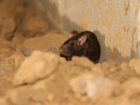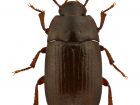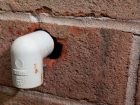
Proactive pest control for poultry barns
By Alice Sinia PhD
Features Barn Management Production Animal Welfare annex Broiler production Canada Egg production Livestock Production Pests Poultry litter management Producer tools Turkey productionWhile complete elimination may be unrealistic, with the right approach, poultry producers can reduce pest pressures.
 To protect against rodents, seal gaps around the building’s exterior. Mice can squeeze through holes as small as a dime.
To protect against rodents, seal gaps around the building’s exterior. Mice can squeeze through holes as small as a dime. The most sustainable strategy, for both the environment and your staff, is Integrated Pest Management (IPM). IPM is a business-savvy and environmentally friendly approach to pest management that focuses on non-chemical techniques to prevent pest activity, using chemical solutions as a last resort.
For poultry producers, IPM is a best practice, as pesticides can harm livestock and jeopardize food safety if not applied correctly.
To get started with an IPM program, you need to identify your pest risks, implement preventive techniques and establish a system for ongoing monitoring.
Identify weak points
For poultry producers, completely eliminating pests is an unrealistic goal. However, you can reduce pest pressures to acceptable levels. That is why it is important to include an initial inspection in your pest management strategy. During the inspection, work with a pest management provider to determine the pest types and pressures inside and outside the poultry house. Using these insights, you can establish action thresholds for responding to pest activity and develop a strategy for preventing pests that is customized to your facility. For example, less than 100 beetles scattered around the building will not pose an immediate threat but sighting more than 100 beetles does call for control.
Prevent pest activity
With knowledge of your pest risks in hand, work with your pest management provider to develop an IPM program that includes proactive techniques like proper sanitation, ongoing maintenance and deliberate exclusion. These methods are a good first step toward controlling pest populations, as they manipulate pests’ natural environment instead of using potentially harmful chemicals. Here are a few techniques to protect against the most common poultry pests:
Rodents
- Seal gaps around the building’s exterior. Mice can squeeze through holes as small as a dime.
- Keep grass mowed short and landscaping trimmed to eliminate hiding places for insects and rodents.
- Trim back tree branches that hang over or touch buildings.
- Minimize water sources, like puddles, ditches and ponds.
- Clean spilled food, fruit and feed as soon as possible.
- Store food in sealed containers.
Flies
- Implement proper manure management. Remove manure daily and make sure stockpiled manure is covered and kept dry.
- Fit trash cans with tight fitting lids, remove trash daily and wash the bins regularly. Also, position outdoor dumpsters at least six metres from a building’s exterior.
- Repair torn window and door screens.
- Install air curtains on exterior doors to create a positive airflow that pushes flying pests back outside.
Beetles
- Install and maintain door sweeps on all exterior doors.
- Inspect incoming shipments for signs of pest activity and quarantine or reject infested items.
- Use the “first in, first out” rule for food products for proper stock rotation.
- Install a gravel strip (at least 46 cm) around the building to deter crawling pests.
- Seal cracks around doors, windows, utilities and the foundation to prevent pests from getting inside.
Keep an eye on trends
IPM relies on communication – between you, your staff and your pest management provider. Once your IPM program is in place and staff have adopted these best practices, it’s important to continue monitoring pest activity. You can monitor pest activity directly with traps or indirectly by training staff to report signs of activity. Over time, pest pressures can change, and an effective monitoring and documentation procedure will help you track trends and adjust your program as needed. In doing so, you can also be sure that your resources are used effectively and that any chemical treatments are used sparingly and target only the problem areas.
When facilities adopt an IPM approach, they reap the rewards. There’s one big difference between businesses that use IPM and those that don’t. For customers without IPM, their response is always reactive, and pest infestations can easily get out of hand, leading to expensive remediation and damage to their brand. The farmers who correctly implement IPM practices rarely experience widespread infestations and save time and money in the long run.
U.S.-based Tyson Foods said that IPM “provides the strict pest management and sanitation guidelines [they] need to help ensure [their] products are processed in a sanitary environment.” After implementing IPM techniques, they have seen perfect scores on the pest management portion of their third-part audits.
Case Farms also emphasizes the importance of IPM for food safety at their fully integrated poultry farming and processing facilities. Their quality assurance manager said, “A program that initiates IPM, which encourages prevention methods, is key. In this business, you have to be proactive.”
Defend against the lesser mealworm
As the weather warms up, pests will come out in droves. One common pest for the poultry industry is the lesser mealworm – also known as the litter beetle. As they build up in broiler house litter, lesser mealworms can cause big problems. In addition to damaging feed and irritating poultry workers, they can tunnel into insulation and wooden beams, leading to expensive repairs. They also carry and spread diseases like Salmonella, E. coli and infectious bursal disease.
To prevent an infestation at your facility, follow the three steps of an IPM program:
1. Inspect
• Lesser mealworms are brown or black and typically about four to six mm long.
• They are often found in floor litter where they feed on poultry feed, droppings and carcasses. You may also spot them in feed storages, especially if the feed is damp, moldy or old.
2. Implement-Sanitation is crucial
• Keep litter dry by reducing sources of moisture and fixing leaks.
• Clean up spilled feed immediately.
• Keep loose litter packed down by moving feeders and waterers when you can.
• Regularly clean and dispose of litter.
3. Monitor
• Keep an eye out for the lesser mealworms and adjust your program if you find them in new areas.
• Document your activity so that you can identify trends and pressure points over time.
If you suspect lesser mealworms are invading your litter, get in touch with your pest management provider to help assess the situation and develop a plan for eliminating and preventing this pest.
Print this page




